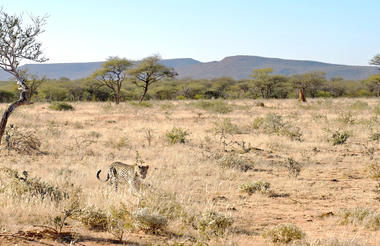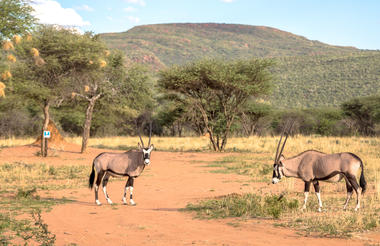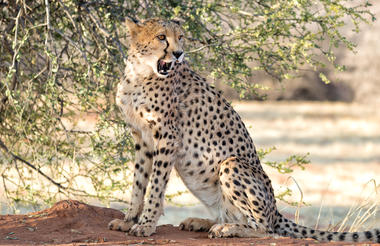Namibia posesses some of the most stunning landscapes in Africa, and a trip through the country is one of the great road adventures. Natural wonders such as that mighty gash in the earth at Fish River Canyon and the wildlife utopia of Etosha National Park enthrall, but it’s the lonely desert roads where mighty slabs of granite rise out of swirling desert sands that will sear themselves in your mind. It’s like a coffee-table book come to life as sand dunes in the world’s oldest desert meet the crashing rollers along the wild Atlantic coast. Among all this is a German legacy evident in the cuisine and art nouveau architecture, and in festivals such as Windhoek’s legendary Oktoberfest. Namibia is also the headquarters of adventure activities in the region, so whether you’re a dreamer or love hearing the crunch of earth under your boots, travel in Namibia will stay with you long after the desert vistas fade.
Windhoek is Namibia’s capital, home to an international airport and a plethora of restaurants, shops, entertainment venues and accommodation options. The city is clean, safe and well-organised, with a colonial legacy that is reflected in its many German eateries and shops, and the widespread use of the German language. Windhoek has an interesting mix of historical architecture and modern buildings, many of which are worth a look, including the Alte Feste (Old Fort), the 1896 Christuskirche (Christ Church), and the more contemporary Supreme Court.

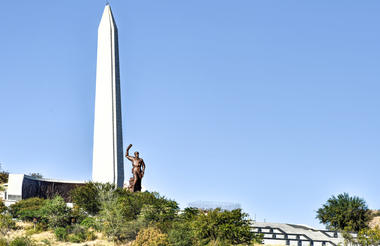
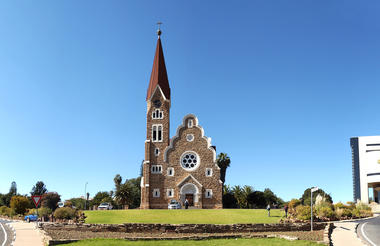
Set just 250 kilometres from the bustling capital of Namibia, the 10,000-hectare Intu Afrika Kalahari Game Reserve presents a landscape of unparalleled natural splendour. Deep red and clay-coloured dunes fan into the distance, decorated with areas of grasslands, shrubs, and trees. The park is home to an impressive array of wildlife, including black wildebeest, springbok, oryx, giraffe, and a large population of meerkats. This is the perfect place to learn about the ancient way of life; visitors can follow a !Kung guide through the desert and learn survival techniques. Make sure to take a look at the exquisite handmade crafts in the village. Hiking, 4x4 excursions, and quad-biking will appeal to adrenaline seekers.



The intermittent Fish River has created Africa’s largest and the world’s second largest canyon. Hot, dry and stony the 160 km long, at times 27 km wide and 550m deep canyon is awe inspiring. At the southern end are the renowned hot springs of Ai-Ais.



The only rocky part of the 1,500km Namib coastline and poised between sand and sea, Lüderitz is a remote frontier at the very end of everything - or the beginning depending on which way you look at history.
The only rocky part of the 1,500km Namib coastline and poised between sand and sea, Lüderitz is a remote frontier at the very end of everything - or the beginning depending on which way you look at history.
Lüderitz is trapped at the end of a long tarred road that squeezes through the Koichab Pan of the Great Sand Sea to the north, and the forbidden territory of the diamond fields in the south; the Antarctic-fed Benguela current effectively seals off any hope of eastward salvation.
And yet, against all odds and a fits and starts upbringing, Lüderitz is a thriving town with little to keep it there but for its isolation and the charm of its incongruous location. This German town of about 25,000 inhabitants was born out of necessity in 1487 when Bartholemu Dias sailed his little flotilla into the natural bay created by the rocky peninsula. Centuries later the the bay was no more than an obscure anchorage on the spice route when whales and guano attracted fierce commercial interest in the 19th century.
The region fell into German hands one year after a merchant named Adolf Lüderitz bought the bay and the coastline down to Orange River in 1883. The subsequent discovery of diamonds transformed this German enclave into a thriving port, which was promptly forgotten when richer bounty was discovered way down south in Oranjemund.
The fascinating and the bizarre mix like sand and sea in this twisted land that requires a two-night visit if not more.
Lüderitz is an anachronism of 19th century Germany. Its older buildings have towers, turrets, oriel windows, bay windows, gables and steep roofs and the town is locked in a sleepy microcosm that defies modern notions of time.
Attractions in the town include Goerke Haus - a grand restored palace; Felsenkirche - a fine Victorian-Gothic church; the Lüderitz Museum, which has historical, ethnic, flora and fauna displays; Nautilus Hill on a clear afternoon for a taste of the desolation that surrounds the town; and the carpet factory, which is reviving demand for karakul wool.
Lüderitz Bay is dotted with islands and lined with rugged inlets. Daily boat cruises take you along the wild coastline with a good chance of encountering endemic Benguela dolphins, Cape fur seals and a rare breeding colony of African penguins. Birders should look out for Damara terns and greater flamingos.
The Lüderitz Peninsula is a scenic round trip with picnic spots and good photo-ops at Griffith Bay, Sturmvoglebucht, Diaz Point, Halifax Island, Essy Bay, Eberlanz Höhle, Kleiner Fjord and Grosse Bucht.
The ghost town of Kolmanskop is an eerie remnant of the diamond era at the beginning of the 20th century. This sand-filled skeleton of a town about 10km from Lüderitz was once a prospering community with a clubhouse, restaurant, bars, saloons, a concert hall and a free block of ice per household every day. You can buy diamonds here and join a guided tour for a detailed look at the history of the diamond boom.
The alluring Sperrgebiet, or forbidden zone, requires advanced booking, special permits and personal guides - all worth it. Agate Beach is about 5km north of Lüderitz and its black sand sparkles with mica and the occasional agate; Elizabeth Bay, 40km south of Lüderitz, had a 3 x 5km band of diamond-bearing coarse grits and sands; Bogenfels is a signature rock arch rising 55m above the sea and a day trip there goes by way of more ghost towns and abandoned diamond mines.
Leading out from Lüderitz, the road to Keetmanshoop is paved with a few attractions along the way, not least of which is the dramatic emptiness of the Koichab Pan.
Near Aus is the site of freak flower explosions after the erratic Cape-influenced winter rains. The timing and frequency is less predictable than the Namaqualand phenomenon in South Africa, making the experience all the more exciting. A similar phenomenon occurs in the lilyveld valley near Maltahöhe. The lilies are endemic to the valley and they bloom for about a week after good rains. February and March are the best times to catch this rare - and undiscovered - sight.
Another peculiarity inland of Lüderitz is the feral horses that have settled near the man-made waterhole at Garub Pan. Numbering about 150, these horses have adapted to the harsh conditions and roam at will across the Sperrgebiet.
Yet another oddity - and likely explanation as to the origin of the desert horses - is a sandstone fortress called Duwisib Castle. Complete with turrets, battlements, jacaranda trees and a lush lawn, this strange sight perches among the rugged hills as if it were dropped intact by a castle-bearing spaceship.
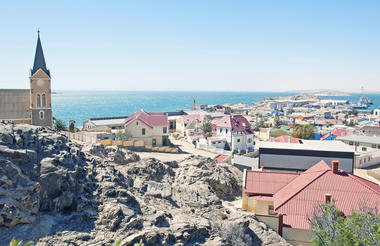
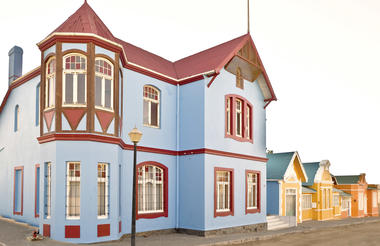
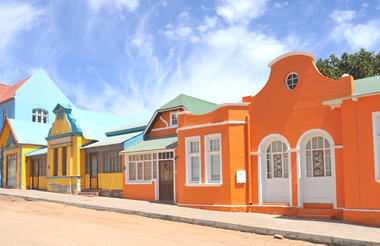
Sossusvlei is where you will find the iconic red sand dunes of the Namib. The clear blue skies contrast with the giant red sand dunes to make this one of the natural wonders of Africa and a photographers heaven. Aside from the attractions at Sossusvlei - Dune 45, Hiddenvlei, Big Daddy and Deadvlei - other attractions in the area include the Sesriem Canyon and Namib-Naukluft National Park, where the mountains of the Namib meet its plains.
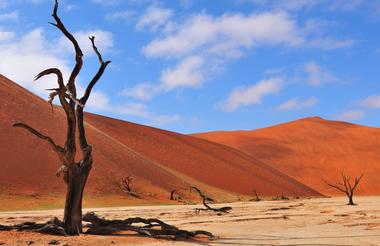
Swakopmund, with its tree-lined avenues, a pleasant climate during the summer and an infinite number of adrenaline-pumping activities available, turns out to be one of the main holiday destinations in Namibia. Its colonial buildings and the morning fog brought by the cold ocean current of the Benguela make it look like a typical German town which, however, inserted in the Namib desert, gives it a very special charm. Walvis Bay is famous for its wetland birds. The greater wetlands area consists of the tidal lagoon, man-made salt pans and an arm of sand that ends at Pelican Point. The Walvis Bay lagoon

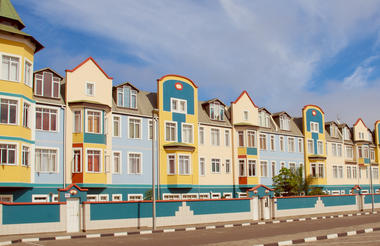
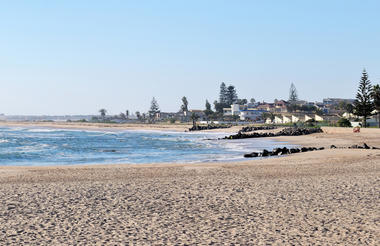
Twyfelfontein is a site of ancient rock engravings in the Kunene Region of north-western Namibia.
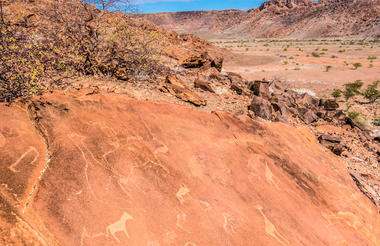
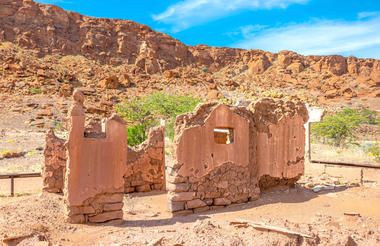
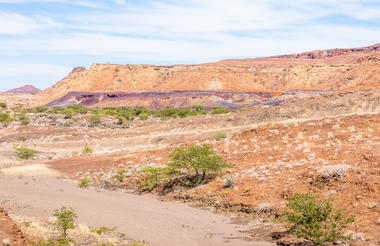
Sharing the southern boundary with Etosha National Park, the prolific 30 000-hectare private Ongava Game Reserve is considered one of the top private game reserves in the region, enjoying global recognition for exceptional conservation, groundbreaking research and exciting safari experiences. The landscape is characterised by vast open plains dotted with salt plans and abundant wildlife. Visitors can easily access Etosha through Andersson’s Gate in the south.
Known for its luxury lodges made out of natural materials, Ogava is a popular destination for those looking to immerse themselves in nature. The reserve offers visitors the perfect combination of wildlife safari experiences within and around the Etosha National Park. One of Ongava’s top attractions is its rhino population and guests can experience the thrill of getting close to these majestic creatures. Popular activities include: night game drives, guided nature walks, bird watching and 4x4 guided game drives.
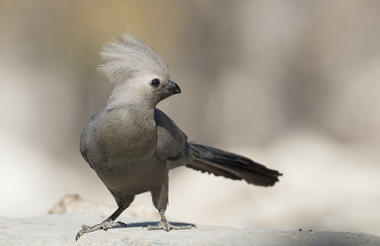
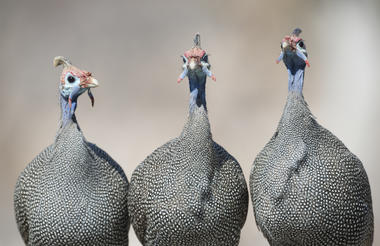
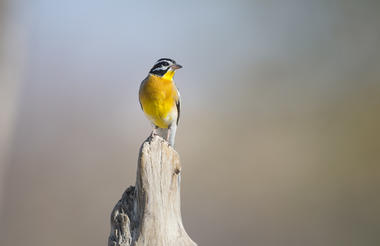
Situated east of Etosha, bordering Fisher's Pan, Onguma Game Reserve is one of Namibia's best-kept secrets. The reserve offers visitors the opportunity to experience Africa in all her beauty and diversity. Onguma Game Reserve features over 34000 hectares of protected land scattered with a variety of wildlife including plains game, black rhino, kudu, giraffe, zebra, lion, cheetah, leopard and more than 300 bird species. The seasonal rains attract thousands of migrating birds to the Fisher’s Pan wetland area. The neighbouring Etosha National Park is home to a rich array of wildlife, including four of the Big 5. Visitors can enjoy game drives, guided walks and rhino research drives within the private reserve as well as wildlife safaris into Etosha National Park to view abundant game in the largest national park in Namibia.



Halfway between Windhoek and Etosha lies the well-known Okonjima Nature Reserve. The 22 000 ha Nature Reserve is surrounded by 96 km of fence and was finally completed in 2010. Okonjima is home to AFRICAT, a Carnivore Conservation, which gives the captive carnivores a second chance to be released back into the wild and to take the time it needs, to become a completely independent hunter - in a protected area right in the middle of commercial farmland! Also in the Reserve is a 2000 ha 'safe' zone around Plains Camp, Bush Camp, Bush Suite, the Omboroko Campsite as well as the PAWS Environmental Education Centre.
